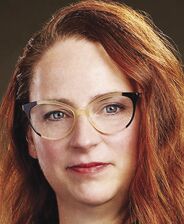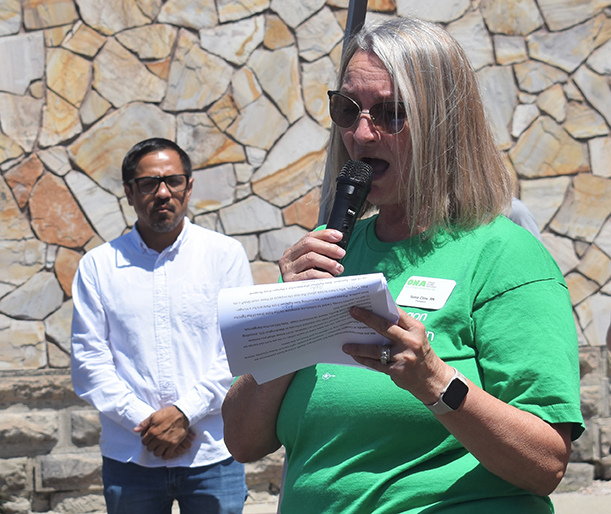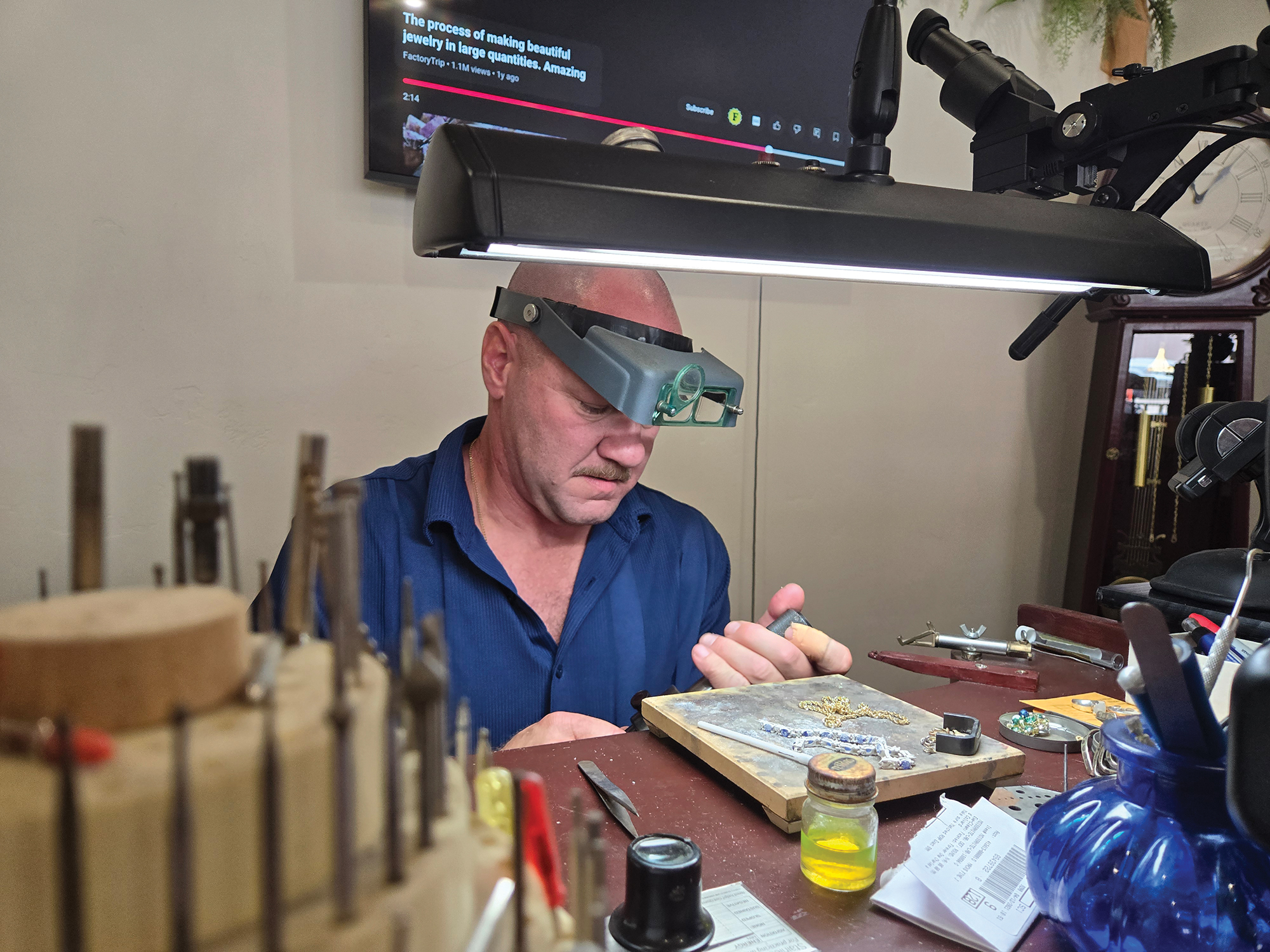COVID surge taxes hospital
Published 2:30 pm Wednesday, September 15, 2021

- Lynn
By JAYSON JACOBY
jjacoby@bakercityherald.com
Dr. Dave Richards concedes that he questioned, earlier in the pandemic, whether all healthy people should be vaccinated against COVID-19.
He wasn’t sure he would be inoculated.
But after treating patients during the dramatic increase in infections in Baker County over the past six weeks or so, Richards, who is medical director for the emergency department at Saint Alphonsus Medical Center-Baker City, has no lingering doubts.
“This is simple — get vaccinated,” Richards, who is vaccinated, said during an interview on Friday, Sept. 10 in the emergency department at the Baker City hospital.
“It’s a slam dunk.”
Richards said he’s convinced, nine months after vaccines became available, that they are safe.
“We’ve got good data on the vaccines,” he said.
As for the benefits of vaccination, Richards said his experience since late July, when Baker County’s case numbers began to rise along with the patient load at the hospital, has been unequivocal.
“We don’t see sick people that have been vaccinated,” he said. “You can still be infected, and you might have a few rough days, but you’ll probably be fine.”
That’s not necessarily the case, though, with people who are not vaccinated and who contract COVID-19, said Richards and Priscilla Lynn, president and chief nursing officer at Saint Alphonsus in Baker City.
Lynn said that several of the COVID-19 patients transferred during August from the Baker City hospital to Saint Alphonsus Medical Center in Boise, because they were sick enough to need a higher level of care, were not vaccinated.
The average age of these severely ill COVID-19 patients has also dropped significantly over the past several weeks, Lynn said.
Earlier in the pandemic, she said, a majority of COVID-19 patients were 60 or older.
But with vaccination rates higher among older county residents — 61.8% of residents 60 and older are vaccinated, compared with 37.6% of those between 12 and 59 — Lynn said the Baker City hospital is seeing few COVID-19 patients 60 and older.
“This has become a pandemic of young and unvaccinated people,” she said.
According to the Baker County Health Department, of the county’s 189 cases from Sept. 1-12, more than half — about 58.5% — were in residents from age 10 to 49.
During that period, about 17.5% of cases were in people 60 and older.
People nine and younger, who aren’t eligible to be vaccinated, accounted for slightly more than 16% of the county’s cases.
Recently, multiple COVID-19 patients with severe symptoms have been transferred from Baker City to the Boise or Nampa hospital because they need a higher level of care.
Ashley Dunten, a registered nurse at Saint Alphonsus in Baker City who has treated many COVID-19 patients, said the situation at the hospital has been vastly different since late July.
For most of the pandemic, Dunten said, the situation at the Baker City hospital wasn’t especially hectic, in large part because the hospital routinely sent COVID-19 patients who needed hospital care to Boise or Nampa.
But the recent substantial increase in infections in county residents has had a major effect on operations at the Baker City hospital, Dunten said.
Both she and Richards said the hospital has treated considerably more COVID-19 patients, and for longer periods, than in the past.
“This isn’t like the early stages,” Dunten said. “We didn’t get hit hard here. Now we are.”
Like Richards, Dunten advocates for everyone eligible to be vaccinated.
Dunten said it frustrates her that some people don’t trust her advice regarding vaccines, but they would trust her to give potentially life-saving treatment.
In addition to seeing more people who have serious symptoms from a COVID-19 infection, Richards said there have been more people coming to the emergency room who have COVID-19 but don’t need to be admitted because their illness is relatively mild.
He said that on one day last week, 12 to 15 people came to the emergency room, all of them positive for COVID-19.
At times, the Baker City hospital has treated multiple COVID-19 patients for extended periods, Lynn said.
That has an outsized effect on the hospital’s staffing capacity, Richards said. Nurses and doctors who treat COVID-19 patients have to wear full protective equipment, and it’s difficult and time-consuming for them to change into and out of that to shift from a COVID-19 patient to others who don’t have the virus, Richards said.
Hospital staff have also had to miss work due to a positive test or because they had close contact with someone who tested positive, Lynn said.
Richards said it’s fortunate that Saint Alphonsus hospitals in Boise and Nampa, as was the case earlier in the pandemic, have been able to continue accepting for treatment most Baker County patients who are severely ill.
But that situation is “tenuous,” Lynn said.
Capacity at the larger Boise and Nampa hospitals in the Saint Alphonsus system is limited, she said, and each day officials at all hospitals in the system, including Baker City, have a phone conference to discuss the situation.
“So far we’ve been able to navigate that,” Lynn said. “But we are very concerned that there could be a day when we have to keep a critically ill COVID-19 patient in Baker.”
Dunten, who coordinates patient transfers from the Baker City hospital, said that for most of the pandemic, she had no trouble finding a bed for COVID-19 patients at larger hospitals.
But recently a patient had to stay for eight hours in the emergency room at Baker City before she could arrange a transfer.
More people seeking tests
Veronica Crowder, a physician assistant at the Baker City hospital, has worked in the drive-thru testing clinic since the beginning of the pandemic.
Crowder said she’s been testing many more people over the past several weeks, with 25 to 30 people per day being common, compared with around 10 per day prior to the surge in infections.
And she said a much higher percentage of the tests have been positive for COVID-19 — 30% to 50% recently.
“It’s a huge change from what it was,” Crowder said.
Statistics from the Oregon Health Authority illustrate the trends Crowder cited.
For the week of July 11-17, there were 119 COVID-19 tests given in Baker County, and just two of those — 1.7% — were positive.
The test positivity rate rose to 6.3% for the week July 18-24, and to 29.8% the week July 25-31.
The weekly positivity rate ranged from 15.5% to 19.3% during August.
The numbers of tests per week, meanwhile, more than doubled, from 160 per week from late June through early August, to 394 tests per week from early August through the first week of September.
Another change Crowder has noticed in the past several weeks is that almost all the people who show up for the rapid test — she typically has results within one to two hours — have some sort of symptom.
Some of those people have a common cold or other ailment rather than COVID-19, she said.
Earlier in the pandemic, she said, many people who wanted to be tested didn’t feel sick, but they just wanted to find out whether they might have an asymptomatic case of COVID-19.
In common with Richards and Dunten in the Saint Alphonsus emergency room, Crowder has also noticed a significant drop in the average age of people who show up for tests, with more people younger than 50 than was the case earlier in the pandemic.
During the second week of September, Crowder said she also tested many children.
Besides testing, Crowder also orders the administration of monoclonal antibody treatments to COVID-19 patients. This treatment involves an infusion of antibodies that can bolster the body’s immune system to combat the virus, Crowder said.
The treatment can reduce the severity of symptoms, she said, particularly in patients who are at greater risk of complications due to obesity, diabetes or other factors.
Crowder said all the people to whom she has given the antibody treatment are unvaccinated.
She’s also seen the effects of vaccination among people who subsequently are infected with COVID-19 — what are known as breakthrough cases.
Baker County has had 55 breakthrough cases, 40 of those reported since Aug. 1, according to the OHA. Those 40 cases accounted for 11.1% of the county’s total cases from Aug. 1 through Sept. 5.
Crowder said people she’s tested who have had breakthrough infections have had relatively minor symptoms, including residents who have risk factors such as obesity or diabetes.
In addition to administering tests and treatments such as antibody infusion, Crowder said she also has conversations with people.
“I feel that people are more open to talk to me about things than they were earlier,” Crowder said. “We usually have a good dialogue.”
She encourages residents, even if they think they have a cold, to come to the Saint Alphonsus clinic for a rapid test.
“I would rather someone come to talk to me and have a cold rather than staying away and going around in the community and potentially exposing people,” Crowder said.
Richards emphasizes that people who are not experiencing an emergency but are concerned that they have COVID-19 should use the local nonemergency testing options.
The symptom he has seen that correlates most directly to a COVID-19 emergency is shortness of breath.
Lynn said that although the goal is to avoid overwhelming the emergency department and to prevent asymptomatic or mildly ill COVID-19 patients from potentially bringing the virus to the hospital, she wants to ensure that people with true medical emergencies don’t hesitate to come to the emergency room.
“That’s what we’re here for — any medical emergency,” she said. “Our doors are open.”
“We don’t see sick people that have been vaccinated,” he said. “You can still be infected, and you might have a few rough days, but you’ll probably be fine.”
— Dr. Dave Richards, medical director for the emergency department at Saint Alphonsus Medical Center-Baker City









